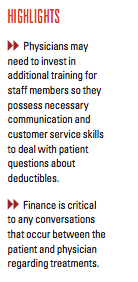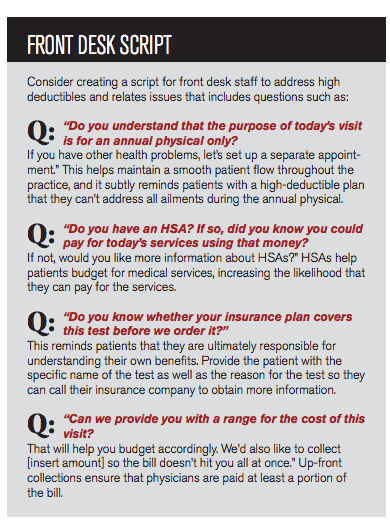Article
Practical solutions to combat high-deductible headaches
Author(s):
There are answers to dealing with patient problems while protecting the bottom line.

Initially, Stacy C. Zimmerman MD, FACP, thought the Affordable Care Act (ACA) and the resulting influx of insured patients would be good for business.
But several years later, the reality has turned out quite different. Many of her patients have high-deductible health plans that require significant out-of-pocket payments before coverage kicks in. This increased patient responsibility has hurt her practice’s cash flow, collections and overall operations.
“Some of the patients with these plans are going to pay for their gas, groceries and electricity long before they pay us,” says internist Zimmerman. “We’re just trying to keep our lights on so we can continue to see patients.”
Physicians who decide to accept high-deductible health plans will likely face operational and financial challenges. The good news is that it is possible to maintain profitability in spite of these obstacles. There are several ways physicians and practices can work effectively with patients who have these plans without compromising the practice’s financial health.
Between a rock & a hard place
Seventy-two percent of employers now offer high-deductible plans, according to the 2016 Health and Well-Being Touchstone Survey conducted by the accounting firm PricewaterhouseCoopers. Thirty-two percent of employees working at these companies are enrolled in these plans-up from 31% in 2015.

Zimmerman, one of only two board-certified internal medicine physicians in a five-county area in rural Arkansas, sees about 150 to 200 patients weekly with the help of one pediatric nurse practitioner. She estimates that between 10% and 15% of her patients have a high-deductible health plan.
A high-deductible health plan is defined as one having an annual deductible of more than $1,300 for an individual or $2,600 for a family, according to the Internal Revenue Service. However, deductibles can go as high as $6,550 for individual coverage and $13,100 for family coverage.
While some physicians choose not to accept certain high-deductible plans due to the financial strain they place on practice operations, Zimmerman says she won’t consider it. “I can’t afford to do that,” she says, adding that she would make far less if she chose not to accept these plans. “I also couldn’t do that with a good conscience. These folks have nowhere else to go. As a small-town doctor, I need to take care of them.”
Anecdotal data suggests that many physicians find themselves in a similar situation as the number of high-deductible plans continues to increase. That’s reinforced by the America’s Health Insurance Plan’s Center for Policy and Research, which found that as of January 2015, 19.7 million individuals were enrolled in a health savings account/high-deductible health plan-up from 17.4 million in 2014.
Cash flow delays
Unpaid patient balances are among the significant challenges related to high-deductible plans. That’s because many practices don’t collect full or even partial payments at the point of service. Instead, they bill for their services retrospectively.
Point-of-service collection isn’t a standard practice because it’s difficult for physicians and their staff members to know exactly what the patient will owe, says Jordan Levitt, executive vice president at FrontRunnerHC, a company specializing in revenue cycle automation. “It often doesn’t feel right for patients to pay for services before they’re rendered when they don’t yet know exactly what they’re buying,” he says.

Derek Kosiorek, CPEHR, CPHIT, principal consultant at the Medical Group Management Association Healthcare Consulting Group, adds that a lack of real-time claims adjudication makes it difficult to predict an amount due. He says an increasing number of practices delay submitting claims for several months to increase the likelihood that a patient will have met his or her deductible, thereby circumventing the need to collect directly from the patient. Though this may be an option, Kosiorek says doing so delays cash flow, so he doesn’t advise it.
Cash flow delays with high-deductible plans are often a problem even when practices submit claims in a timely manner, says Dorothy Thompson, LPN, CMM, practice administrator at Carolina Medical Consultants, a four-physician internal medicine practice in Rock Hill, South Carolina. Prior to the ACA, Thompson says insurance companies generally paid the practice’s claims within two weeks of submission. Now, practices must wait for the explanation of benefits before they can determine what the patient owes. Then they must generate a bill for the patient. “So you’re already behind the eight-ball,” she says.
With a weekly average of 400 visits, Thompson estimates that 10% to 15% of the practice’s patients are covered by high-deductible health plans, the majority of which include a deductible of between $2,500 and $3,500. A few plans go as high as $10,000.
Difficulty forecasting revenue
Another challenge related to high-deductible plans is forecasting revenue and planning.
“It’s a moving target because we’re at the mercy of what goes on at the employer level when the enrollment period opens,” says Yul Ejnes, MD, MACP, an internist with Coastal Medical, a 20-office medical group in Rhode Island that accepts high-deductible health plans. Physicians could see a sudden spike in patients with high-deductible health plans, with a resulting negative effect on the practice’s revenue, he adds.
In addition, physicians can’t predict their revenue from year to year or even month to month because they never know if patients will pay on time or at all, says Robert James Cimasi, MHA, ASA, chief executive officer at Health Capital Consultants, a healthcare financial and economic consulting firm headquartered in St. Louis, Missouri.
Now that the patient is often the payer, it becomes more difficult to predict payment patterns, he adds. In general, practices collect 30% to 85% of the payment that is the patient’s responsibility. Patients with high-deductible plans usually drive the majority of these receivables, he says.
Accounting challenges
Many insurance plans have begun offering built-in health savings accounts (HSA), says Thompson, adding that practices must be able to distinguish between payments from the patient’s HSA and those directly from the insurance company. The checks often look identical, with the only difference being that the insurer’s payment also includes an explanation of benefits.

Thompson says her practice set up an HSA personal pay account type in its billing system so billing staff members could post these payments separately in each patient’s account.
When it comes to overpayments, time is of the essence, says Levitt. State-specific requirements for credit balances may require physicians to refund overpayments to patients and/or payers as soon as 90 days from the date the payment is received, he adds. In addition, some states don’t allow physicians to apply these overpayments to the patient’s next visit. Practices need to know where those payments originate so they can return any overpayments to the correct payer (i.e., the patient or the insurer).
Clinical consequences
Treatment delays are yet another challenge-and perhaps unintended negative consequence-of high-deductible plans.
Ejnes says some patients don’t follow through with treatment recommendations simply because they can’t afford the care. This happens most frequently with diagnostic colonoscopies, which-unlike screening colonoscopies-require a copayment under many high-deductible health plans, he adds.
Medication deductibles also pose a challenge. Ejnes says some of his patients with diabetes can’t afford their insulin treatment, nor can some asthmatics afford an inhaler that sometimes costs $200.
In some cases, patients delay care until their annual physical because high-deductible plans usually waive the deductible for preventive care. Then they expect the physician to address all ailments during that single visit, says Thompson. “When they’re trying to get everything done in one visit, this increases the amount of time the physicians must spend. That slows down our whole patient flow,” she adds.
These delays in care place an increased burden on physicians, who must find ways to treat higher-acuity patients in the most cost-effective way, says Cimasi. It’s too soon to know whether care deferment due to the expenses associated with high-deductible health plans will have a negative effect on health among the general population, he adds.
Working with patients
Successfully meeting the challenges posed by high-deductible health plans requires a mix of patient education and patience on the part of the physician. Consider these four strategies:
01/ Focus on education
Financial counseling. Refer patients with high-deductible health plans to an internal financial counselor who can explain the patient’s estimated financial responsibility and what their plan does-and doesn’t-cover before services are rendered, says Kosiorek.
Practices don’t necessarily need to hire an additional employee to serve in this role. Instead, ask billers or collections staff members who already possess knowledge of the billing process to take turns serving in this role, he adds.
However, these staff members may need additional training so they possess the necessary communication and customer service skills, says Ejnes. “If someone has a large balance due, staff need to know how to approach the patient respectfully, with sensitivity and in a private manner,” he says.
Educational brochures. Focus on what patients need to know about high-deductible plans, basic terminology (e.g., deductible, coinsurance, etc.), insurance company contact information and how the practice can help answer any questions, says Cimasi.
Money-saving tips. Thompson says her practice put together a brochure that identifies the least-expensive places where patients can obtain a bone x-ray, MRI or CT scan. Though this doesn’t directly affect practice revenue, it does build patient loyalty, and it helps patients afford all their healthcare services.
02/ Offer flexible payments
These might include partial up-front payments (e.g., 20% of the anticipated total bill) as well as income-specific payment plans. Some physicians require a flat dollar amount (e.g., $150) for every $500 of services.
“Don’t get so locked into a rigid [payment] structure,” says Ken Kubisty, CHFP, MHA, senior vice president of consulting at the Advisory Board, a research, technology and consulting firm headquartered in Washington, D.C. “It’s critical to figure out what will work for that specific household.” Unworkable solutions invariably cause patients to simply ignore their bills, he adds.
03/ Obtain eligibility and fee estimation technology
These tools help front-office staff estimate patients’ financial responsibilities, thereby reducing the likelihood of an overpayment and making it easier to build patient trust, says Levitt. To be effective, he says, the tools should provide the following information:
- Real-time eligibility verification
- Remaining deductible (and coinsurance for out-of-network providers)
- Fee estimation
04/ Talk about costs
Finances are critical to any patient/physician conversations regarding treatments or other interventions, says Cimasi. “The physician has to help the patient perform a cost-benefit analysis of different options,” he adds.
Ejnes says he often reminds patients that avoiding certain tests, medications or procedures may save money in the short-term but cost them more in the long run. Even so, he often looks for lower-cost solutions when patients can’t afford their deductible. For example, when patients can’t afford the deductible or coinsurance for a colonoscopy, he suggests an annual stool check for blood.
Thompson says physicians at her practice frequently offer sample medications and provide discount cards. But sometimes they need to prescribe a different drug entirely. “A lot of patients are coming to us and saying, ‘I can’t take that medication that you prescribed because it costs too much.’ Then we have to look to see whether there’s something out there that can replace it that’s as good,” she says. “After all, if the patient cannot afford it, they will not take it.”
Zimmerman uses the prescribing module in her EHR to determine the tier for a drug and whether the patient’s insurance will cover the medication. If a patient has questions about drug coverage, she stops the visit and invites her business manager into the exam room to help the patient understand his or her benefits.
“This is very distracting to the doctor-patient relationship,” she says. “I should be able to treat the patient’s problems regardless of their insurance and ability to pay.”




